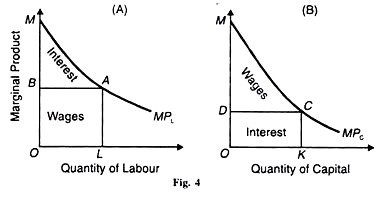The below mentioned article provides an overview on Clark’s Production Exhaustion Theorem.
Assumptions:
Clark based his analysis on the following assumptions:
1. There is free competition in both the product markets and factor markets.
ADVERTISEMENTS:
2. Prices and wages are not manipulated either by government action or collusive agreements.
3. The quantity of each factor is given.
4. There are no changes in the tastes of consumers or techniques of production. It means that the same goods are produced in the same quantities and by the same methods.
5. The quantity of capital equipment is fixed. But the form of capital equipment can be changed to cooperate with the quantity of labour available. It means that in the long-run plants can be adapted and replaced in keeping with the availability of labour.
ADVERTISEMENTS:
6. Workers are interchangeable and of equal efficiency. It means that there is a single wage rate for all occupations because there is perfect labour mobility.
Explanation:
Given these assumptions, Clark summarised the working of such an economy in a diagram shown as Figure 4 (A) and (B). There are two factors of production: labour and capita Units of labour are shown on the horizontal axis and the MP of labour on the vertical axis in Panel (A) of the Figure.
ADVERTISEMENTS:
The MPL curve is the marginal physical product of labour which falls steadily as more workers are employed with fixed capital. OL represents the number of workers available for employment.
If all are employed the MP of the last worker is LA who is paid LA wage. Since all workers receive the same wage rate, the total wage bill is the number of workers OL multiplied by the wage rate LA (= OB), i.e., the area ОLAB.
The triangular area ABM goes to the owners of capital as the residual interest. Thus the total product is the area OMAL which has been distributed as OLAB as wages to workers and ABM is interest to owners of capital i.e. OMAL = OLAB+ ABM. It shows that the total product of the economy has been fully distributed between labour and capital, the two factors in the economy.
If labour is a fixed factor and capital is a variable factor in the economy, it can again be shown that the total product is fully exhausted. Now units of capital are taken on the horizontal axis and the MP of capital on the vertical axis and MPc as the marginal physical product curve of capital in Panel (B) of the Figure.
Given the same quantity of labour OK of capital is employed with KС as its marginal product so that the rate of interest is OD = KС per unit of capital.
This gives the area OKCD as the total interest income on capital. The workers receive wages equal to the area CDM. Thus the total product of the economy is the area ОМСK which is fully exhausted between owners of capital as interest equal to the area OKCD and workers as wages equal to the area CDM so that ОМСK = OKCD + CDM.
It should be noted that for the product exhaustion theorem to be valid in Clark’s view, area OLAB in Panel (A) must equal D CDM in Panel (B), and area OKCD of Panel (B) must equal D ABM in Panel (A) of the Figure.
